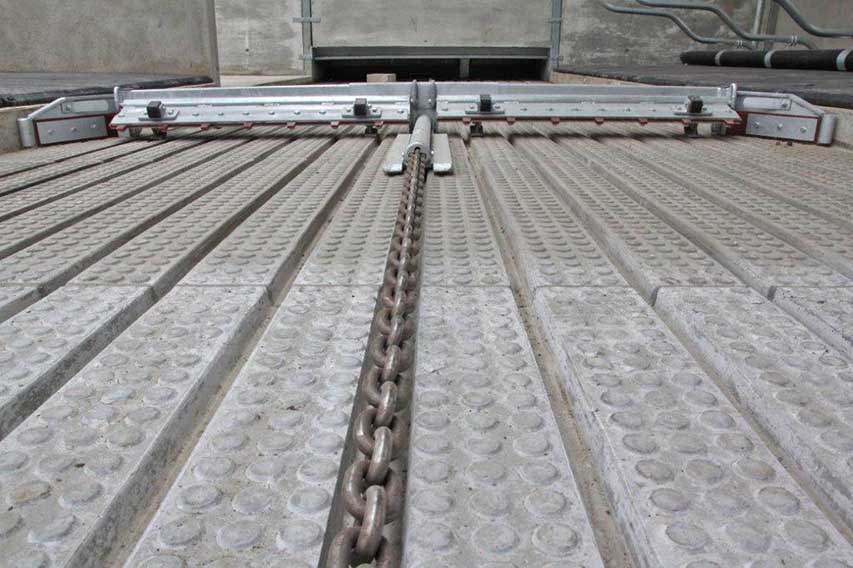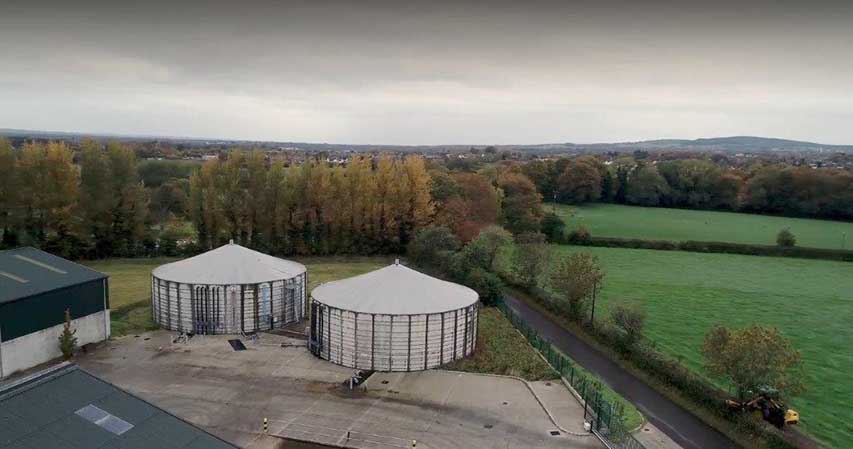Managing slurry and livestock buildings to reduce ammonia emissions
By Martin Kirk, Air Quality Team, CAFRE, Greenmount Campus.
Ammonia is a naturally occurring gas containing nitrogen and hydrogen, with the chemical formula NH3.
Some agricultural practices and activities encourage the loss of nitrogen into the atmosphere in the form of ammonia.
When faeces (containing the enzyme urease) and urine (containing urea) mix together, ammonia is produced and released. Ammonia is a key air pollutant having a significant effect on the environment and indirectly affecting human health.
In this article Martin Kirk, CAFRE Technologist, explains the various methods farmers can implement to reduce ammonia emissions linked to livestock buildings, slurry management and how tree planting has been shown to reduce ammonia emissions.
Scraping
Ammonia is released from livestock buildings through the breakdown of urea (in urine) by the enzyme urease (in faeces).
Most Northern Ireland’s ammonia emissions (96%) come from the housing of livestock and subsequent storage and spreading of livestock manures, particularly cattle (64%).
Martin explains: “Within livestock buildings, it is a challenge to keep both urine and faeces separated and therefore reduce ammonia emissions.
“Where these are not regularly removed to storage, or urine is allowed to pool across large areas, significant volumes of ammonia are released.
“Even after scraping, the remaining film of urine and faeces will continue to release ammonia but to a much lesser extent.”
An important mitigation strategy that could be implemented on farms across Northern Ireland is frequent scraping of slurry covered floors.
The optimum scraping frequency, to reduce ammonia emissions, is every two hours. This is not a new recommendation, with research conducted as far back as 1998 showing scraping at 2 hours and 6 hours results in ammonia reductions of 49% and 27% respectively.
Martin highlighted the important message to take from this research is that the effectiveness of using scraping to control ammonia emissions reduces as the scraping interval increases.

Emission reduction floor design
Scraping systems will reduce ammonia emissions further when installed in combination with low emissions floor designs. These designs incorporate grooves/channels or slopes which discourage pooling of urine and facilitates its rapid separation from faeces and removal to slurry storage.
A comprehensive programme of research, to assess a floor designs emission reduction capability, is conducted at Wageningen University in the Netherlands.
This system, of independent assessment, offers a fair and balanced comparison between different floor designs.
As the predominant cattle enterprise in the Netherlands is dairy, this research is conducted using dairy cattle. Research has allocated a baseline emission of 13kg of ammonia per cow per year; this is from conventional solid concrete floors.
Some of the best performing emission reduction floors will reduce this to 6-7kg of ammonia per cow per year, a 46%-53% reduction, in conjunction with a two hourly scraping frequency.
Martin went on to conclude by saying: “For other areas soiled by slurry outside of livestock pens, areas such as collecting yards and handling facilities, further emission reductions can be achieved through frequent washing.”
Covering Outdoor slurry storage
After removal from livestock buildings, slurry is commonly stored in below ground tanks, above ground slurry stores or lagoons.
Emissions from external slurry storage can be reduced by limiting the airflow across the surface of the slurry.
This can be achieved by installing impermeable or semi-permeable covers, or by increasing the depth of stores to reduce the ratio of surface area to volume of the stores.
Ammonia emission rates from slurry storage vary according to environmental factors such as temperature and wind speed.
Shielding the slurry surface from airflow allows ammonia concentrations to build up beneath the cover, which suppresses further emissions. Several external slurry storage cover options are available.

Tensioned cover
An impermeable plastic cover shaped like a tent, supported by a central column with a small vent in the top, avoiding gas pressure build-up as the level of the slurry rises during storage periods. This cover style has an emission reduction capability of 80%.

Plastic floating cover
Like the tensioned cover, this cover is made of an impermeable plastic sheet. It differs in design as it rests directly on top of the slurry, rising and falling with the slurry level. Similarly, this cover has an emission reduction capability of 80%.
Floating plastic tile – These are a floating plastic tile which, can be hexagonal in shape, when added to slurry, combine creating an interlocking barrier between the slurry and the air. While this cover allows rainwater to enter the tank, its emission reduction capability is around 60%.
Light expanded clay aggregates – These are small, pebble like, clay products with a hollow irregular internal lattice structure which float and create an airflow barrier on the slurry surface.
They range in size from approximately 0.5-2cm. These products are comparable to the floating plastic tile cover with an emission reduction capability of around 60%.
Trees to air
Another novel mitigation method is the use of site-specific tree planting to capture ammonia emissions. Air from nearby livestock buildings is naturally directed into a relatively open tree canopy.
The movement and turbulence of the air, through the trees, encourages ammonia gases to be deposited on the tree and leaf surface.
In addition to the main canopy, an area of denser non deciduous planting on the downwind edge of the main canopy acts as a backstop, forcing air flow up and through the canopy.
Additional benefits include, a grazable area under the main canopy, carbon sequestration, increased biodiversity and visibility screening of livestock housing.
While this method has multiple benefits, the establishment of a fully functioning main canopy and backstop can take many years. This can be overcome by planting older saplings. To maximise the benefit of tree planting advice should be sought to ensure trees are placed in the correct location and the most appropriate species selected.
Conclusion
While most farms will have multiple ammonia emission sources, management techniques and equipment are available to reduce emissions from livestock buildings and slurry management. The retention of nitrogen within the farm system will benefit both the farmer and the surrounding environment.
Consultation
The Department of Agriculture, Environment and Rural Affairs (DAERA) has launched a consultation on its draft Ammonia Strategy and is keen for anyone with an interest to participate and provide their views.
This public consultation is open for a period of 8 weeks until 23:59, 3 March 2023. We welcome as many views as possible from all interested organisations and individuals.
An information event has been organised for each of the three CAFRE campuses. Greenmount 24th January, Enniskillen 25th January and Loughry 31st January.
Each meeting will commence at 7.30pm and last approximately one hour.
To reserve your place at a meeting please register through Eventbrite at:
www.cafre.ac.uk/draft-ammonia-strategy.
For further information including details of how to respond go to: www.daera-ni.gov.uk/consultations

























